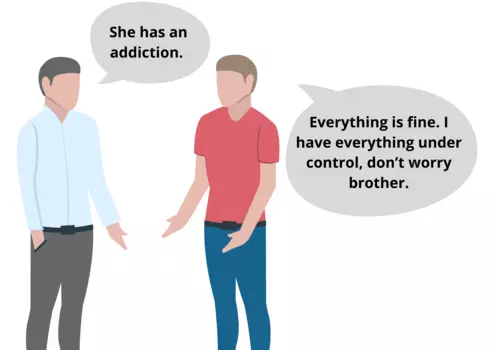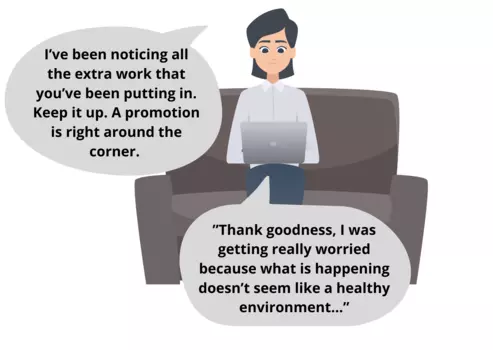One must be extremely cautious when linking codependency with narcissistic abuse. The most dangerous approach one could have when learning about the correlation between codependency and narcissistic abuse is a one-size-fits-all mindset.
A codependent in a narcissistic relationship is someone who willingly stays with the narcissist despite the abuse they’re suffering. They neglect their own well-being in an attempt to save their abuser. A codependent derives their self-esteem from the sense of nobility they obtain from enduring the abuse.
While there are some victims of narcissistic abuse who could certainly be considered codependent, it’s an extremely controversial subject because a very small percentage of victims of narcissistic abuse truly fit the criteria of codependency. If we were to use the term “codependent” as a blanket description of victims of narcissistic abuse we would be bolstering a victim blaming culture.
Our society is already the biggest enabler of narcissistic abuse so having a single minded approach to the link between codependency and narcissistic abuse would only add onto the mountain of seemingly immovable hurdles victims of narcissistic abuse must overcome on their healing journey.
A Comprehensive Understanding of Codependency
In the beginning stages of codependency it was a term that focused on addiction, specifically in family systems that enabled an addict through denial and a lack of communication.
1st Example
A mother who denies that her son has an addiction problem and/or consistently rescues them from financial, legal, or other types of trouble would be considered a codependent because by expending all of her resources to help her addicted son, she’s denying her own healthy needs and builds her self-esteem from the sense of nobility she obtains from constantly “rescuing” her son.

2nd Example
A father constantly finds different ways to justify, rationalize, and ultimately normalize his wife’s addiction despite the harm it’s having on their children. He’s making a conscious decision to put the well-being of his wife’s addiction ahead of the well-being of the rest of the family and builds his self-esteem from the sense of nobility he obtains from keeping the family together.

The important takeaway from both of those examples is that the codependent’s self-esteem is entirely dependent on the addict’s behavior. If the son decides that he no longer wants the help of his mother, she would be distraught.
If the wife decided to run off, the husband would lose sight of himself. A codependent builds their self-esteem off of the abuser’s behavior which is often erratic and uncontrollable and therein lies the danger.
How Has Codependency Turn Into a Term That Is Associated With Narcissistic Abuse?
There is a very long list of negative effects that having an unhealthy/abusive upbringing has on a child. These types of environments are notorious for having unavailable, unresponsive, and inconsistent primary caregivers.
It’s very common for children who grow up in unhealthy/abusive environments to gravitate towards abusive relationships in adulthood simply because it is familiar. As you can imagine, this makes them incredibly susceptible to trauma bonded relationships.
What Is a Trauma Bond?
A trauma bond is a deep emotional attachment that is formed between an abuser and their victim through physical and/or emotional abuse. A trauma bond is incredibly difficult to break because they’re very similar to a drug addiction.
We covered this much more thoroughly in our article Why Do Trauma Bonds Feel Like an Addiction but what happens is that a narcissist will place their victim up on an emotional pedestal through narcissistic mirroring and future faking.
Narcissistic mirroring is a technique abusers use to quickly absorb information about their victim’s identity and use the same information to reflect or “mirror” a falsified identity back to the victim that is designed to fill the void in their lives and manipulate them into thinking they have a special connection.

Future faking is when an abuser will make a false promise in the future to get something they want in the present. It’s important to know that future faking can be verbal, like a promise, or non-verbal, like their behavior. Non-verbal future faking manifests in the form of narcissistic mirroring. The abuser is pretending to be someone that they aren’t, which causes the victim to envision a healthy, happy, and secure relationship in the future.

Once the narcissist senses that their victim has become attached to the healthy, happy, and secure connection that they’ve fabricated, they’ll remove their falsified identity and begin the devaluation phase. This phase is home to all of the blatant forms of narcissistic abuse like rage, gaslighting, scapegoating, and of course, devaluing.
This is really confusing for victims of narcissistic abuse because it feels like one day they were flying high towards a happy, healthy, and secure future with someone they had a special connection with and then the next the same person is really irritable, abusive, explosive, and distant.
This is where cognitive dissonance comes into play. Cognitive dissonance is a theory that suggests when we experience an inconsistency among our beliefs, knowledge we have, and behavior we experience, it causes a tremendous amount of psychological tension. To ease this tension we change one or more of the elements causing the inconsistency to make everything consistent.
In a narcissistic relationship, this behavior manifests in the form of the justification, rationalization, and ultimately normalization of abuse. So, when the narcissist senses that the victim is reaching their breaking point and could possibly leave, they use intermittent reinforcement to send them into a limbo state of cognitive dissonance.
How?
Intermittent reinforcement is the delivery of a reward at irregular intervals. The “reward” that narcissists use is the information they’ve absorbed about the victim’s identity. By using this information they trigger the victims’ sense of hope that the healthy, happy, and secure future they once believed in will come back. This causes victims of narcissistic abuse to justify, rationalize, and ultimately normalize the abuse, causing them to be trauma bonded to the relationship indefinitely.

What’s the Correlation Between a Trauma Bond and Codependency?
In a Harvard Health Publishing article they stated that people with addictions tend to show these three Cs:
- Craving for the object of the addiction, which can be mild to intense
- Loss of control over use of the object of the addiction
- Continued engagement with the object of the addiction in spite of harmful consequences.
Those who are trauma bonded crave the high points, the “reward”, of the dysfunctional relationship that they’re in. They lose control over themselves in the pursuit of the “reward” that the narcissist gives them. And they continue to support the relationship despite the consequences.
The reason that trauma bonded victims are often labeled as codependent is because some people see that they continue to support the relationship and assume it is because they’re in denial and have a need to “rescue” the abuser like a codependent would.
When the truth is that many victims of trauma bonded relationships aren’t in denial of the abuse they’re enduring but they remain in the relationship because of the addiction and/or other factors like financial abuse, low self-esteem, children under the age of eighteen, fear and so on.
What Should You Take Away From This Article?
We have to be really careful not to equate codependency with trauma bonded victims of narcissistic abuse. There are definitely some victims of narcissistic abuse who could be classified as codependent. However, what differentiates them from trauma bonded victims of narcissistic abuse is knowledge.
How?
A majority of victims of narcissistic abuse who are trauma bonded to their abuser are able to acknowledge that what they’re experiencing is abuse and escape the relationship once they have the knowledge required to do so.
When a codependent has the information needed to acknowledge that the person they’re protecting is an abuser, they dismiss it and remain in denial.
It’s not easy to tell the difference between a codependent victim of narcissistic abuse and a trauma bonded victim of narcissistic abuse. The reason being that some characteristics that are associated with codependency are denial, holding back emotions, depression, hypervigilance, and anxiety and these are all characteristics that trauma bonded victims of narcissistic abuse display as well.
Before trauma bonded victims of narcissistic abuse have the knowledge they’re in denial of the abuse, they put their abuser’s emotions ahead of their own, they’re depressed, consumed with self-doubt and self-blame, they’re hyper-vigilant and constantly walking on eggshells to avoid narcissistic rage, and they’re extremely anxious.
So, there are certainly some narcissistic relationships that do reflect codependency but in the narcissistic realm we can rarely speak in absolutes, especially when it comes to codependency.
About the Author

Hey, I’m Elijah.
I experienced narcissistic abuse for three years.
I create these articles to help you understand and validate your experiences.
Thank you for reading, and remember, healing is possible even when it feels impossible.
References:
James P. Morgan Jr., What Is Codependency? Journal of Clinical Psychology 47 (5) 1991.
